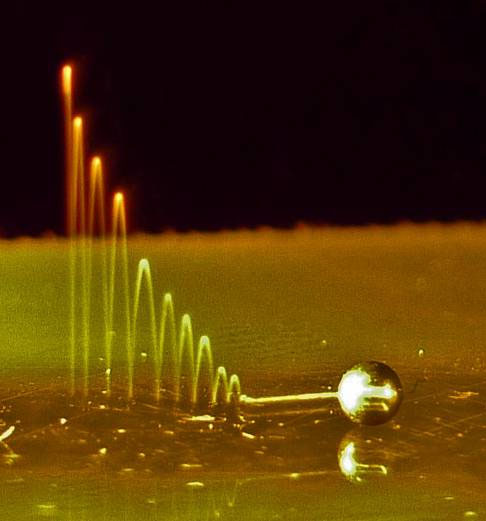Ball Impact and Sensor Calibration Project
Ball impact is used as a calibration source for absolute system calibration. While studying this source, I was able to test the limits of Hertzian impact theory.

The images below show frames of a video of a 1.58 mm diameter steel ball bouncing repeatedly on a 50 mm thick steel plate. Each time the ball hits the plate, shock waves are radiated from the point of impact. Those waves can be detected by nanoseismic sensors like the one shown above. The signals shown in blue are the waves recorded by one of those sensors located beneath the plate. If we zoom in on the first waves to be recorded from the second bounce, we can see distinct pulse-shaped wave arrivals (a small one followed by a taller one). The first wave is the P wave and the second one is the S wave. The shape of the waves is directly proportional to the force that the ball imposes on the plate. The width of the pulse is equal to the time the ball spends in contact with the plate (about 5 microseconds for this case).

The impact of a tiny ball on a body can be used as a known calibration source for sensor and system calibration. The signals below show a comparison between recorded signals and the surface displacement we would expect to find based on Hertz theory of impact and the theory of elastic wave propagation in a 50 mm thick steel plate. These signals are from the impact of a tiny (0.4 mm) ruby ball. The first peak is the direct P-wave that propagates through the thickness of the plate while the subsequent peaks are waves which have reflected through the thickness of the plate. The excellent match between theory and experiment is made possible by the broadband nature of the Glaser-type conical piezoelectric sensors.

Ball impact is not the only calibration source. A different calibration source is the sudden fracture of a thin walled glass capillary. The glass tube is slowly loaded on its side, as shown below, untill it suddenly shatters. Instead of imposing an impulsive force on the specimen, the capillary fracture imposes a step function source. The amplitude of the step is equal to the 'static' load that the capillary tube was holding just before it factured and the load dropped to zero. The force at fracture, and thus the amplitude of the step, can be measured with a force sensor for absolute calibration.

One advantage of the ball impact source is that it is possible to model this source numerically with a method such as finite elements, shown below. The numerical simulation can be used to validate the theoretical solutions and to better visualize the waves as they propagate throught the plate. The image below shows a cross section of the waves propagating through a 50 mm thick steel plate in response to the impact of a 1.58 mm steel ball at five different times.

More information about these topics can be found in the following papers:
McLaskey, G., and Glaser, S. (2010) Hertzian impact: experimental study of the force pulse and resulting stress waves, Journal of the Acoustical Society of America 128(3) pp. 1087-1096. pdf
McLaskey, G., Glaser, S., (2009) "High-fidelity conical piezoelectric transducers and finite element models utilized to quantify elastic waves generated from ball collisions," in: M. Tomizuka, C. Yun, V. Giurgiutiu (Eds.), Proc. SPIE, vol. 7292, 72920S-1 - 72920S-18. pdf